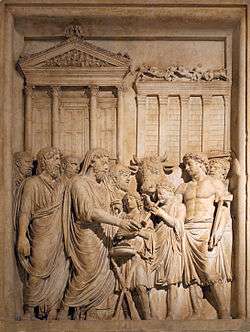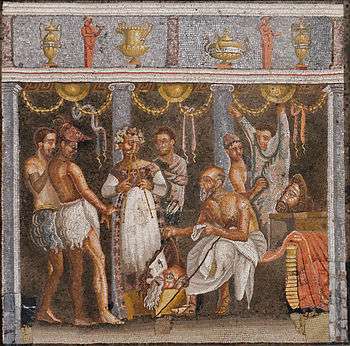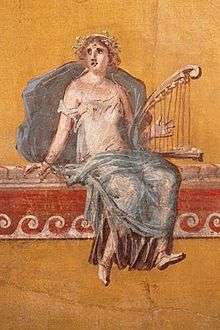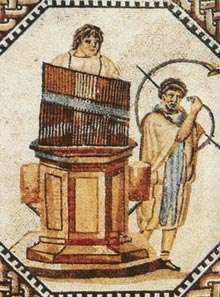Music of ancient Rome
The music of ancient Rome was a part of Roman culture from earliest times. Music was customary at funerals, and the tibia (Greek aulos), a woodwind instrument, was played at sacrifices to ward off ill influences. Song (carmen) was an integral part of almost every social occasion. The Secular Ode of Horace, for instance, was commissioned by Augustus and performed by a mixed children's choir at the Secular Games in 17 BC. Under the influence of ancient Greek theory, music was thought to reflect the orderliness of the cosmos, and was associated particularly with mathematics and knowledge.
Etruscan music had an early influence on that of the Romans. During the Imperial period, Romans carried their music to the provinces, while traditions of Asia Minor, North Africa and Gaul became a part of Roman culture.
Music accompanied spectacles and events in the arena, and was part of the performing arts form called pantomimus, an early form of story ballet that combined expressive dancing, instrumental music and a sung libretto.
Musical notation
The Romans may have borrowed the Greek method of 'enchiriadic notation' to record their music, if they used any notation at all. Four letters (in English notation 'A', 'G', 'F' and 'C') indicated a series of four succeeding tones. Rhythm signs, written above the letters, indicated the duration of each note.
The Romans may have tuned their instruments to Greek modes.
Instruments
Roman art depicts various woodwinds, "brass", percussion and stringed instruments. Roman-style instruments are found in parts of the Empire where they did not originate, and indicate that music was among the aspects of Roman culture that spread throughout the provinces.

Wind instruments
- The Roman tuba was a long, straight bronze trumpet with a detachable, conical mouthpiece like that of the modern French horn. Extant examples are about 1.3 metres long, and have a cylindrical bore from the mouthpiece to the point where the bell flares abruptly, similar to the modern straight trumpet seen in presentations of 'period music'. Since there were no valves, the tuba was capable only of a single overtone series that would probably sound familiar to the modern ear, given the limitations of musical acoustics for instruments of this construction. In the military, it was used for "bugle calls". The tuba is also depicted in art such as mosaics accompanying games (ludi) and spectacle events.
- The cornu (Latin "horn") was a long tubular metal wind instrument that curved around the musician's body, shaped rather like an uppercase G. It had a conical bore (again like a French horn) and a conical mouthpiece. It may be hard to distinguish from the buccina. The cornu was used for military signals and on parade. The cornicen was a military signal officer who translated orders into calls. Like the tuba, the cornu also appears as accompaniment for public events and spectacle entertainments.
- The tibia (Greek aulos - αὐλός), usually double, had two double-reed (as in a modern oboe) pipes, not joined but generally played with a mouth-band capistrum (Greek phorbeiá - φορβεία) to hold both pipes steadily between the player's lips. Modern changes indicate that they produced a low, clarinet-like sound. There is some confusion about the exact nature of the instrument; alternate descriptions indicate each pipe having a single reed (like a modern clarinet) instead of a double reed.
- The askaules — a bagpipe.
- Versions of the modern flute and panpipes.
-
Cornu at the Limesmuseum in Aalen, Germany
-
Cornicines on Trajan's Column (2nd century)
-

Horn player on the Ludovisi sarcophagus (3rd century)
-

Tibia player accompanying a sacrifice led by Marcus Aurelius
-

Panpipes played by Pan and aulos by a maenad (Mildenhall Treasure, 4th century)
String instruments


Right image: wall fresco of a seated woman with a kithara, 40-30 BC, from the Villa Boscoreale of P. Fannius Synistor; late Roman Republic.
- The lyre, borrowed from the Greeks, was not a harp, but instead had a sounding body of wood or a tortoise shell covered with skin, and arms of animal horn or wood, with strings stretched from a cross bar to the sounding body. The lyre was held or cradled in one arm and hand and plucked with the other hand. The Romans gradually abandoned this instrument in favour of the more sophisticated cithara, a larger instrument with a box-type frame with strings stretched from the cross-bar at the top to the sounding box at the bottom; it was held upright and played with a plectrum. The strings were tuned "by adjusting sticks seen in the engraving."
- The cithara was the premier musical instrument of ancient Rome and was played both in popular and elevated forms of music. Larger and heavier than a lyre, the cithara was a loud, sweet and piercing instrument with precision tuning ability. It was said some players could make it cry. From cithara comes the word guitar. Though the guitar more directly evolved from the lute, the same mystique surrounds the guitar idols of today as it did for the virtuoso cithara players, the citharista, and popular singers of ancient Rome. Like many other instruments, it came originally from Greece, and Greek images portray the most elaborately constructed citharas.
- The lute (pandura or monochord) was known by several names among the Greeks and Romans. In construction, the lute differs from the lyre in having fewer strings stretched over a solid neck or fret-board, on which the strings can be stopped to produce graduated notes. Each lute string is thereby capable of producing a greater range of notes than a lyre string. Although long-necked lutes are depicted in art from Mesopotamia as early as 2340–2198 BC, and also occur in Egyptian iconography, the lute in the Greco-Roman world was far less common than the lyre and cithara. The lute of the medieval West is thought to owe more to the Arab oud, from which its name derives (al ʿūd).
Organs
Mosaics depict instruments that look like a cross between the bagpipe and the organ. The pipes were sized so as to produce many of the modes (scales) known from the Greeks. It is unclear whether they were blown by the lungs or by some mechanical bellows.
The hydraulic pipe organ (hydraulis), which worked by water pressure, was "one of the most significant technical and musical achievements of antiquity". Essentially, the air to the pipes that produce the sound comes from a mechanism of a wind-chest connected by a pipe to a dome; air is pumped in to compress water, and the water rises in the dome, compressing the air and causing a steady supply to reach the pipes (also see Pipe organ#History). The instrument goes back to the ancient Greeks and a well-preserved model in pottery was found at Carthage in 1885.
The hydraulis accompanied gladiator contests and events in the arena, as well as stage performances. It might also be found in homes, and was among the instruments that the emperor Nero played.
Percussion
- Variations of a hinged wooden or metal device (called a scabellum) — a 'clapper' — used to beat time. Also, there were various rattles, bells and tambourines.
- Drum and percussion instruments like timpani and castanets, the Egyptian sistrum, and brazen pans, served various musical and other purposes in ancient Rome, including backgrounds for rhythmic dance, celebratory rites like those of the Bacchantes, military uses, hunting (to drive out prey) and even for the control of bees in apiaries. Some Roman music was distinguished for its having a steady beat, no doubt through the use of drums and the percussive effects of clapping and stamping. Egyptian musicians often kept time by snapping the fingers.
- The sistrum was a rattle consisting of rings strung across the cross-bars of a metal frame, which was often used for ritual purposes.
- Cymbala (Lat. plural of cymbalum, from the Greek kymbalon) were small cymbals: metal discs with concave centres and turned rims, used in pairs which were clashed together.

Music in society
In spite of the purported lack of musical originality on the part of the Romans, they did enjoy music greatly and used it for many activities. Music was also used in religious ceremonies. The Romans cultivated music as a sign of education. Music contests were quite common and attracted a wide range of competition, including Nero himself, who performed widely as an amateur and once traveled to Greece to compete.
Discography
- Synaulia, Music of Ancient Rome, Vol. I – Wind Instruments - Amiata Records ARNR 1396, Florence, 1996.
- Synaulia, Music of Ancient Rome, Vol. II – String Instruments - Amiata Records, ARNR 0302, Rome, 2002.
- Thaleia, Carmina Canere Music of Ancient Rome, Vol. I –Tarragona - Spain 2012.
- Ludi Scaenici, E Tempore Emergo - Rome, Italy - 2001
- Ludi Scaenici, Festina Lente - Rome, Italy - 2011
- Ensemble Kérylos, dir. Annie Bélis, De la pierre au son : musique de l'antiquité, K617, 1996.
- Ensemble Kérylos, dir. Annie Bélis, D'Euripide aux premiers chrétiens : musique de l'antiquité, 2016.
Notes

- ^ Naerebout, p. 146.
- ^ Ginsberg-Klar, pp. 313, 316.
- ^ Habinek, passim.
- ^ Habinek, pp. 90ff.
- ^ Scott, p. 404.
- ^ Frankin, p. 95; Starks, pp. 14ff.
- ^ Ulrich and Pisk, .
- ^ Pierce, p. 45.
- ^ Ginsberg-Klar, p. 313.
- ^ Ulrich and Pisk, p. 25.
- ^ Bonanni, plate 2.
- ^ Ginsberg-Klar, p. 314.
- ^ Bonanni, plate 3.
- ^ Bonanni, unnumbered plate between plates 48 and 49, with commentary on the facing verso page.
- ^ Ginsberg-Klar, p. 316.
- ^ Williams, .
- ^ Cook.
- ^ Scott, p. 413.
- ^ Walter, p. 23.
- ^ Suetonius, cited in Scott, p. 418.
- ^ Marcuse, pp. 137, 304.
- ^ Scott, .
- ^ Spring, p. 1.
- ^ Higgins and Winnington-Ingram, pp. 62–71.
References
- Bonanni, Filippo. 1964. Antique Musical Instruments and their Players: 152 Plates from Bonanni's 18th-Century "Gabinetto armonico" , with a new introduction and captions by Frank Ll. Harrison and Joan Rimmer. New York: Dover Publications. Reprint of the 1723 work, Gabinetto armonico, with supplementary explanatory material.
- Boethius, Anicius Manlius Severinus. De institutione musica. (English edition as Fundamentals of Music, translated, with introduction and notes by Calvin M. Bower; edited by Claude V. Palisca. New Haven: Yale University Press, 1989.)
- Cook, James H. 1999. "Organ History: Origin and Development through 800 AD". James H. Cook's Faculty Personal Website, at Birmingham-Southern College (Accessed 19 December 2012).
- Franklin, James L., Jr. 1987. "Pantomimists at Pompeii: Actius Anicetus and His Troupe". American Journal of Philology 108, no. 1
- Ginsberg-Klar, Maria E. 1981. "The Archaeology of Musical Instruments in Germany during the Roman Period". World Archaeology 12, no. 3:
- Habinek, Thomas. 2005. The World of Roman Song. Baltimore: Johns Hopkins University Press.
- Higgins, R. A., and Reginald P. Winnington-Ingram. 1965. "Lute-Players in Greek Art." Journal of Hellenic Studies 85:62–71.
- Marcuse, Sibyl. 1975. Musical Instruments: A Comprehensive Dictionary, corrected edition. The Norton Library. New York: W. W. Norton & Company, Inc. ISBN 0-393-00758-8.
- Naerebout, Frederick G. 2009. "Dance in the Roman Empire and Its Discontents". In Ritual Dynamics and Religious Change in the Roman Empire. Proceedings of the Eighth Workshop of the International Network Impact of Empire (Heidelberg, July 5–7, 2007): Brill.
- Pierce, John R. 1983. The Science of Musical Sound, New York: Scientific American Books.
- Scott, J. E. 1957. 'Roman Music' in The New Oxford History of Music, vol.1: 'Ancient and Oriental Music,' Oxford: Oxford University Press.
- Smith, William. 1874. A Dictionary of Greek and Roman Antiquities. New York: Harper.
- Spring, Matthew. 2001. The Lute in Britain: A History of the Instrument and Its Music. Oxford University Press, 2001.
- Starks, John H., Jr., 2008. "Pantomime Actresses in Latin Inscriptions". In New Directions in Ancient Pantomime Oxford and New York: Oxford University Press.
- Suetonius. Nero, xli, liv.
- Ulrich, Homer, and Paul Pisk. 1963. A History of Music and Musical Style. New York: Harcourt Brace Jovanoich.
- Walter, Don C. 1969. Men and Music in Western Culture. New York: Appleton-Century-Crofts. ISBN 0-390-91600-5.
- Williams, C. F. Abdy. 1903. The Story of the Organ. London: Walter Scott Publishing Co.; New York: Charles Scribner & Sons.
Further reading
- Benzing, G. M. 2009. "'Se vuoi far soldi, studia la cetra': musica e luxus nell’antica Roma". In Luxus: Il piacere della vita nella Roma imperiale: [Torino, Museo di antichita, 26 settembre 2009 – 31 gennaio 2010], edited by Elena Fontanella, Rome: Istituto Poligrafico e Zecca dello Stato. ISBN 9788824011631.
- Comotti, Giovanni. 1989. Music in Greek and Roman Culture, translated by Rosaria V. Munson. Ancient Society and History. Baltimore: The Johns Hopkins University Press. ISBN 0801833647 (cloth); ISBN 080184231X (pbk).
- Hagel, Stefan, and Christine Harrauer (eds.) (2005). Ancient Greek Music in Performance: Symposion Wien 29. Sept.–1. Okt. 2003. Vienna: Verlag der Österreichischen Akademie der Wissenschaften. ISBN 3-7001-3475-4.
- Landels, J. G. 1999. Music in Ancient Greece & Rome. London and New York: Routledge.
- Maas, Martha. 2001. "Kithara". The New Grove Dictionary of Music and Musicians, second edition, edited by Stanley Sadie and John Tyrrell. London: Macmillan Publishers.
- West, M[artin] L[itchfield]. 1992. Ancient Greek Music. Oxford: Clarendon Press; New York: Oxford University Press. ISBN 0-19-814897-6 (cloth) ISBN 0-19-814975-1 (pbk).
- Wille, Günther. 1967. Musica Romana: Die Bedeutung der Musik im Leben der Römer. Amsterdam: P. Schippers.
External links
- Ensemble Kérylos, a music group led by scholar Annie Bélis and dedicated to the recreation of ancient Greek and Roman music.
- Musica Romana, musicarchaeology, scientific review of ancient Roman music as well as performances, bibliography and descriptions for instruments and notations online (English and German).
- The Thesaurus Musicarum Latinarum (TML), an evolving database of the entire corpus of Latin music theory written during the Middle Ages and the Renaissance.
- Synaulia, dedicated to the reconstruction of historical musical instruments, sound theatre, dance on the basis of ethnology.
- Greek origins of Roman music
- Juvenal: Satire XI
- Ludi Scaenici Performance and research on the music and dance in the ancient Rome
